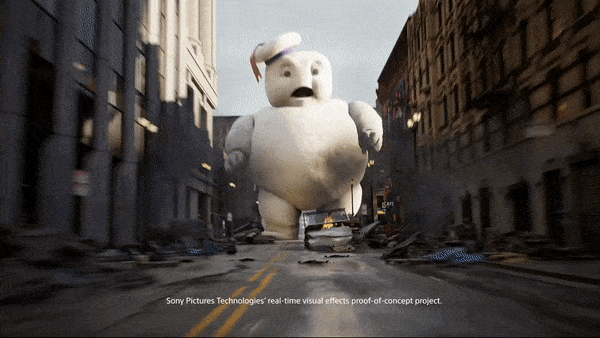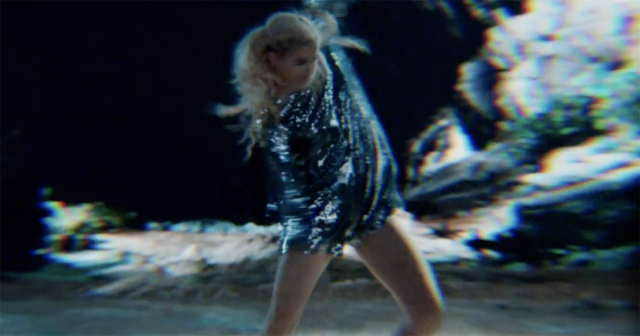
TL;DR
- Sony unveiled a two-minute “Ghostbusters” short film directed by Jason Reitman at its annual Creator’s Conference.
- Enabled by real-time technology and virtual production techniques, the proof-of-concept project was a collaboration between SPE, Ghost Corps, Pixomondo, PlayStation Studios and Epic Games.
- The production team utilized Unreal Engine to create a four-square-mile digital twin of New York City. This virtual environment allowed for virtual scouting, animatic sequences, and real-time adjustments, fostering a more interactive and collaborative process.
- The integration of real-time technologies is paving the way for the next generation of filmmakers, enabling them to create movies in environments and with characters that were previously inaccessible.
A few weeks ago, Ghostbusters fans received a not entirely unanticipated but nonetheless disappointing setback when it was announced that the latest movie has been postponed to 2024 due to the ongoing Hollywood strikes. But Sony still had something to keep fans engaged until next year, unveiling a new Ghostbusters short at its annual Creator’s Conference.
The two-minute short film, which you can watch in the video at the top of the page beginning at the 07:31 mark, is an exciting real-time visual effects proof-of-concept project from Sony Pictures Entertainment in collaboration with Ghost Corps, Pixomondo, PlayStation Studios and Epic Games. Set in the heart of New York City, it features the iconic Ecto-1, the 1959 Cadillac ambulance conversion that ferried the Ghostbusters team and their equipment through the city, and the Stay-Puft Marshmallow Man in all his multi-storied glory.
Pushing the limits of virtual production, the project was helmed by Ghostbusters: Afterlife director Jason Reitman, who appeared alongside key creatives for a panel discussion on the making of the short at the Sony Creator’s Conference. Joining Reitman was Guy Wilday, VP of Interactive Technology at Sony Pictures Entertainment, Miles Perkins, director of Unreal Engine Business for Media & Entertainment at Epic Games, David Murrant, VP of Creative Arts at Sony Interactive Entertainment, and Mahmoud Rahnama, chief innovation officer at Pixomondo.
Collaboration and Innovation
The Ghostbusters real-time visual effects project is a groundbreaking collaboration that brought together industry giants and creative minds. Sony Pictures Entertainment spearheaded the project, providing the creative direction and technological support, while Reitman brought his unique vision and expertise.
The Ghost Corps team, originally formed by Sony to create a Ghostbusters cinematic universe and expand the Ghostbusters brand into films, television series and merchandise, helped safeguard the Ghostbusters legacy and brand integration. They were joined by Pixomondo, bringing its visual effects and real-time expertise, and PlayStation Studios, which provided motion capture services on their world-class mocap stages, all powered by Unreal Engine from Epic Games.
“As a director, there’s nothing more important to me than performance,” Reitman commented, reflecting on the innovative real-time process. “Pixomondo gave me the opportunity to direct a real life actor and get a performance out of a digital character that I would have never been able to do if I was standing over an artist’s shoulder.”
More than just a short film, the project is an exploration of what’s possible with real-time technology. The production team utilized Unreal Engine to create a live, interactive digital twin of New York City. “And from that point on, everything went into the game engine,” said Wilday. “We virtually scouted all of the locations within the virtual environment. We built animatic sequences to start building out the content we needed within the engine for the final shoot. We did technical preparation on the mocap stage where we integrated render hardware and our VCAM system, and then finally brought all this together for the production shoot itself to capture the content for our short.”
The on-set experience allowed for immediate feedback and adjustments. This real-time approach fostered a more dynamic and spontaneous creative process, enabling the production team to experiment and innovate on the fly.
“It was really eye-opening for me, first of all, how fast Jason picked it up and started shooting,” Rahnama recounted, comparing the real-time approach with the traditional process for approving VFX shots, which could involve multiple QuickTime files and pages of copious notes, often crossing in the night. “That would take weeks, if not months,” he continued. But on this project, he said, “I could see that Jason was just coming up with shots, back-to-back.”
Happy Accidents
The new Ghostbusters short isn’t just a showcase of technological prowess, but also a testament to the creative freedom and unexpected discoveries that real-time technology can offer. The four-square-mile digital twin of New York City became a creative sandbox for the production team, affording nearly endless possibilities.
One “happy accident,” as Rahnama called it, occurred when Reitman inadvertently walked inside an apartment building with a window that provided a view to the exterior location. “Jason’s like, ‘This is such a cool shot, let’s shoot something like this.’ And this wouldn’t never have happened with traditional visual effects,” he said. “It was really good to see how interactive and collaborative that was.”
Reitman was also struck by the incident. “We had never planned to go inside a building,” he said. “And I remember thinking, ‘Wait, I can go inside the building.’”
The unplanned moment was revelatory, said Reitman. “If you’re shooting a movie, you can’t just start opening people’s apartments and be like, ‘Hey, I’m just gonna do a shot from inside your window. That cool?’” he explains. “And so the idea that now we’re inside, we’re getting this perspective of Stay Puft walking by, and now I’m telling the actor, ‘Hey, take a look inside the window, and I’m gonna try to catch you like looking inside the window, and maybe cock your head a little, and then look down,’ doing all that stuff in real time, on the same day that we’re doing a car spinning around a corner, and like 10 other different beats. And that’s what made it great.”
Perkins compared the creative process to driving a car, emphasizing the importance of being able to seamlessly engage with technology to allow the poetic nature of storytelling to come to the forefront. He also highlighted the critical role of real-time technology in allowing moments like these to occur. He explained, “I think it’s absolutely critical, again, in visual effects. We’ve been building 2D images. But what happens when you enable teams to make the four square miles and that we can go around and start to look at things the way you would in the real world. And to me, that is just it’s so incredibly freeing, and also to be able to move the team and do a set, like somewhere else where you got to crane and you have all these other things. I think it’s really empowering.”
These happy accidents reveal the transformative potential of real-time technology. It’s not just about efficiency or cutting-edge visuals; it’s about fostering a more dynamic and spontaneous creative process. It’s about breaking away from the constraints of traditional filmmaking methods and embracing the unexpected moments that can lead to truly innovative storytelling.
Looking to the Future
The future of filmmaking is on the cusp of a revolutionary transformation, driven by the integration of real-time technologies and innovative approaches. The new Ghostbusters short is more than just a technological marvel; it’s a preview of what’s to come. “What thrills me about it is the possibility of independent filmmakers who want to tell their kind of stories, but in environments that they don’t have access to, with characters that they don’t have access to,” said Reitman.
The democratization of virtual production tools is paving the way for the next generation of filmmakers. Murrant envisions new filmmakers embracing the technology to create movies that we wouldn’t have seen before. “So for new people coming in next generation of filmmakers, they’ll hopefully embrace this technology and make their own movies that we wouldn’t have seen before,” he said. “Who could the next Spielbergs, the next Jasons, be? Who’s that next generation coming through and doing great and interesting things we haven’t seen before?”
The project’s significance extends beyond the immediate impact on filmmaking. It symbolizes a shift towards a more collaborative and community-driven approach. “I think we are a community, bringing people together. That’s what filmmaking is, it’s a community of people coming together,” emphasized Perkins.
The convergence of film and games, the emergence of photorealism, and the ability to tell stories in previously inaccessible environments mark a new era in the Media & Entertainment industry. The Ghostbusters short serves as a testament to the boundless possibilities that lie ahead, fostering creativity, collaboration and innovation.


